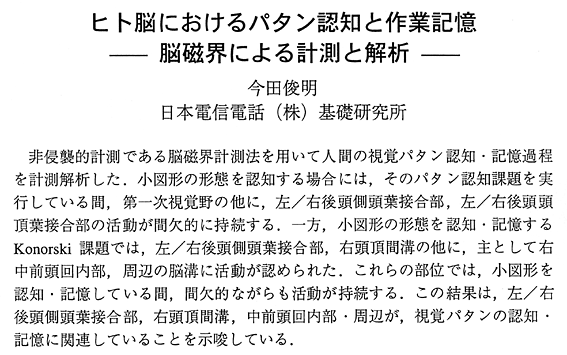Pattern recognition and working memory in the human brain -
Neuromagnetic studies
Toshiaki ImadaNTT Basic Research Laboratories, Atsugi-shi, Kanagawa 243-0198, Japan
Signals were recorded by a whole-scalp neuromagnetometer while the subjects were recognizing (Expts. 1 & 2) or memorizing (Expt. 2) small objects.
In Block A of Expt. 1, the subjects judged the identity of two objects presented to the left or right of the fixation point. In Block B of Expt. 1, the subjects mentally counted the number of small circles (5, 6, or 7) in 12 possible locations. The overall accuracy was significantly lower and the reaction time longer in Block B than in A, reflecting the difficulty of the task. Active areas were identified in the bilateral occipitotemporal and occipitoparietal areas and in the right intraparietal sulcus. In Block B, activation in the left and/or right occipitotemporal regions continued, in 7 out of 9 subjects, until the reaction key was operated. This area, together with the fusiform gyrus, seemed to be involved in pattern recognition of simple objects.
In Block A of Expt. 2, the subject memorized the form of 3 small objects presented in 3 of the 16 possible locations, while in Block B the subject remembered the locations of 3 small objects. The overall behavioral performance was significantly lower in Block A than in B, reflecting the difference in task difficulty. In Blocks A and B, the active areas were found bilaterally in the occipitotemporal and/or occipitoparietal region as well as bilaterally in the intraparietal sulci. Most of the subjects tended to show longer activity in the left occipitotemporal and/or occipitoparietal area and in the right intraparietal sulcus, in comparison with the respective opposite locations. The subjects also displayed longer activity in areas inside and/or surrounding the right, in comparison with the left middle frontal gyrus. These results imply that the left occipitotemporal and/or occipitoparietal region, the right intraparietal sulcus, and the cortical region in or near the right middle frontal gyrus are involved in recognizing and/or retaining visual object information.

